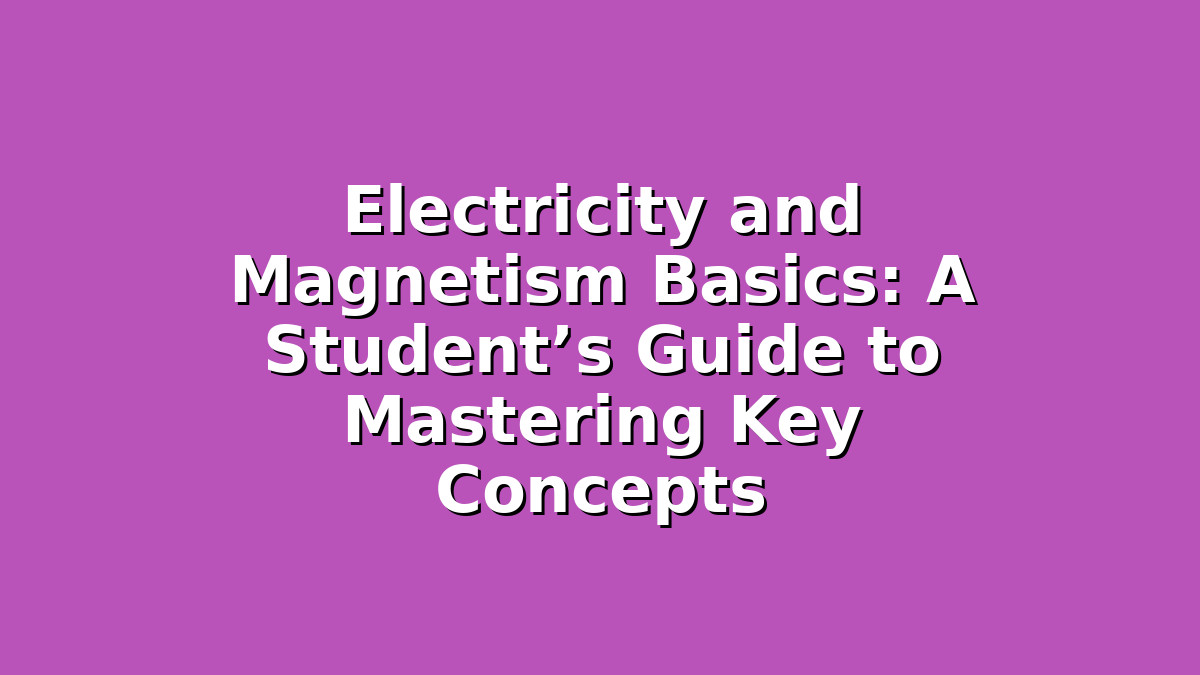If you’re a student preparing for exams or simply brushing up on physics, understanding the basics of electricity and magnetism is essential. These two topics form a crucial part of many science curricula, from high school to early college levels. They not only help you grasp how the physical world operates but also lay the foundation for advanced studies in physics, engineering, and technology. In this article, we’ll break down the essentials of electricity and magnetism and provide practical study tips to help you excel in your exams.
Understanding Electricity: The Flow of Energy
Electricity is all about the movement and interaction of electric charges. At its core, electricity is caused by the presence and flow of electrons, which are tiny negatively charged particles. Here are some fundamental concepts you need to understand:
– Electric Charge: The basic property of matter that causes it to experience a force when placed in an electric and magnetic field. Charges can be positive or negative.
– Current (I): The flow of electric charge, measured in amperes (A). It moves through conductors like wires.
– Voltage (V): Also called electric potential difference, voltage is the energy per unit charge that drives current through a circuit.
– Resistance (R): The opposition to the flow of current, measured in ohms (Ω). Materials with low resistance are called conductors; those with high resistance are insulators.
– Ohm’s Law: This fundamental law relates current, voltage, and resistance: V = IR. It’s essential for solving circuit problems.
Study Tip:
Create flashcards for each of these terms with definitions and units. Use diagrams to visualize current flow and circuit elements. Practice solving numerical problems using Ohm’s Law, as this will boost your confidence during exams.
Magnetism: Invisible Forces and Magnetic Fields
Magnetism is closely related to electricity; in fact, they are two sides of the same coin, known collectively as electromagnetism. Magnetism arises from moving electric charges and intrinsic magnetic moments of elementary particles.
Key points to focus on:
– Magnetic Fields (B): These are regions where magnetic forces can be detected. The field lines around a magnet show the direction and strength of the magnetic field.
– Magnetic Force: A moving charged particle experiences a force when it enters a magnetic field, and this force is perpendicular to both the velocity of the particle and the magnetic field.
– Electromagnets: Created by running current through coils of wire, electromagnets demonstrate the direct link between electricity and magnetism.
– Faraday’s Law of Induction: Changing magnetic fields can induce an electric current in a conductor, which is the principle behind transformers and electric generators.
Study Tip:
Use animations or simulations to see magnetic field lines and forces in action. Drawing magnetic field patterns around different magnets can aid memorization. Working on conceptual questions helps you understand the relationship between electric currents and magnetic effects.
Linking Electricity and Magnetism: Electromagnetism in Practice
The integration of electricity and magnetism is fundamental to many technologies. Understanding how these two phenomena interact deepens your insight into physics and prepares you for more advanced topics.
Important concepts include:
– Electromagnetic Induction: When a conductor moves through a magnetic field or when the magnetic field around a conductor changes, an electric current is induced. This principle is harnessed in generators and transformers.
– Lorentz Force: The total force on a charged particle moving through electric and magnetic fields. This principle explains how devices like cyclotrons and mass spectrometers work.
– Maxwell’s Equations (Overview): These four equations summarize the behavior of electric and magnetic fields and how they propagate as electromagnetic waves.
Study Tip:
Summarize key relationships in your own words and solve practical problems that combine electric and magnetic effects. Group study sessions can be particularly helpful here, as explaining concepts to peers reinforces your understanding. Also, practice past exam questions that include electromagnetism scenarios to familiarize yourself with how these concepts are tested.
Conclusion: Mastering Electricity and Magnetism for Exam Success
Electricity and magnetism may seem challenging at first, but with consistent study and practice, you can master these topics. Focus on understanding the fundamental concepts rather than rote memorization. Use visual aids like diagrams and simulations to bring abstract ideas to life. Don’t hesitate to solve plenty of practice problems – this is the best way to build your confidence. Remember, every physicist started with these basics, so stay curious and keep pushing forward. Your hard work will pay off in your exams and beyond.
Good luck, and happy studying!

Responses